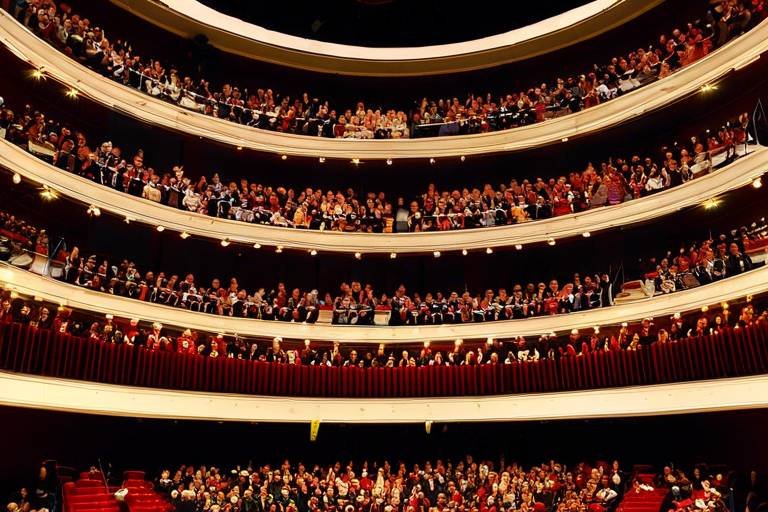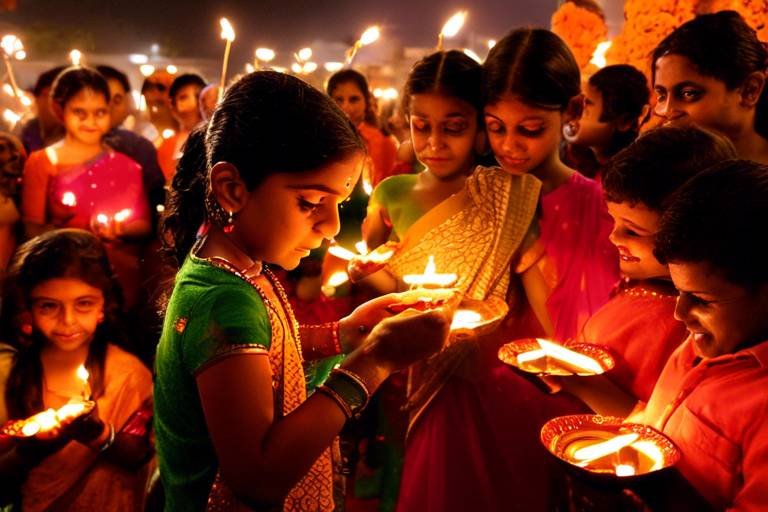The Splendor of South Korea's Andong Mask Festival
Experience the vibrant and cultural extravaganza of South Korea's Andong Mask Festival, a celebration that blends tradition, artistry, and history into a mesmerizing spectacle. The festival serves as a window into the rich heritage of the region, showcasing traditional masks, dynamic dance performances, and a fusion of past and present artistic expressions.

History of Andong Mask Festival
The Andong Mask Festival has a rich history that dates back centuries, rooted in the ancient shamanistic rituals and folk traditions of South Korea. This vibrant celebration has evolved over time to become one of the most significant cultural events in the region, attracting visitors from around the world to experience the unique blend of tradition and artistry.
Originally, the festival served as a way to ward off evil spirits and bring blessings to the community through the wearing of masks. These masks, intricately designed and steeped in symbolism, were believed to possess protective powers and were an integral part of the traditional ceremonies and performances.
As the Andong Mask Festival continued to grow in popularity, it expanded to include various forms of entertainment, including dance performances, music, and theatrical presentations. The festival became a platform for artists and performers to showcase their talents and creativity, while also preserving and promoting the cultural heritage of South Korea.
Throughout its history, the Andong Mask Festival has undergone transformations and adaptations, reflecting the changing times and influences of modern society. Despite these changes, the festival has remained true to its roots, honoring the traditions and customs that have been passed down through generations.

Traditional Masks of Andong
The Andong Mask Festival in South Korea is renowned for its captivating display of traditional masks that hold deep cultural significance. These masks, known for their intricate designs and symbolic meanings, play a central role in the festival's celebrations.
Originating from centuries-old shamanistic rituals and folk traditions, the traditional masks of Andong have evolved to represent a wide array of characters from Korean folklore and history. Each mask is carefully crafted to embody specific traits and stories, offering a glimpse into the rich heritage of the region.
One of the most fascinating aspects of the traditional masks is the symbolism embedded in their designs. These masks often depict themes of good versus evil, protection, and spiritual beliefs, reflecting the complex cultural tapestry of Korean society.
During the Andong Mask Festival, visitors have the opportunity to marvel at these symbolic creations up close, gaining a deeper understanding of the cultural nuances and artistic craftsmanship behind each mask. The festival serves as a platform to showcase the beauty and diversity of traditional Korean mask art.
Some of the most iconic masks featured at the festival include the Hahoe masks, known for their exaggerated expressions and vivid colors, as well as the Byeolsin gut masks, which are used in exorcism rituals to ward off evil spirits. Each mask tells a unique story and holds a special place in Korean cultural heritage.

Symbolism in Mask Designs
Symbolism in mask designs plays a crucial role in the rich tapestry of the Andong Mask Festival. Each intricate design carries deep meanings and symbolism, reflecting the essence of Korean culture and history. The masks are not merely decorative pieces but symbolic representations of various characters, themes, and beliefs ingrained in Korean folklore and traditions.
One of the predominant themes depicted in the mask designs is the eternal struggle between good and evil. The masks often embody contrasting qualities, with some representing benevolent spirits, protectors, or heroes, while others personify malevolent forces, demons, or tricksters. These dualities symbolize the eternal balance and conflict between opposing forces in the world.
Moreover, the intricate patterns and motifs adorning the masks are not just ornamental but carry profound spiritual significance. Many designs incorporate symbols of protection, prosperity, and good fortune, aiming to ward off evil spirits, bring luck, and ensure the well-being of the wearer. The masks serve as talismans, embodying the spiritual beliefs and superstitions deeply rooted in Korean society.
Furthermore, the choice of colors, shapes, and expressions in the mask designs conveys nuanced meanings and emotions. From vibrant hues symbolizing vitality and energy to somber tones representing sorrow or contemplation, each color evokes specific feelings and conveys subtle messages about the character portrayed. The expressive features and exaggerated expressions on the masks add depth and drama to the performances, enhancing the storytelling aspect of the festival.

Andong Mask Dance Performances
At the heart of the Andong Mask Festival are the mesmerizing , where the traditional masks truly come to life. These performances are a captivating display of skill, artistry, and storytelling, as talented dancers embody the characters depicted on the masks through intricate movements and choreography.
The transport spectators to a world where ancient tales and folklore unfold before their eyes. The rhythmic beats of traditional music set the stage for a dynamic performance that seamlessly blends tradition with modern creativity.
Throughout the festival, visitors have the opportunity to witness a variety of , each one unique in its portrayal of different characters and narratives. From graceful movements to energetic displays, these performances showcase the diversity and richness of Korean cultural heritage.
One of the most captivating aspects of the is the way in which the dancers convey emotions and stories without uttering a single word. Every gesture, every step, is imbued with meaning, drawing the audience into a world of mystery and enchantment.
As the dancers twirl and leap across the stage, the masks they wear seem to take on a life of their own, transforming into embodiments of ancient spirits and mythical beings. The are not just a form of entertainment; they are a window into the soul of Korean culture and tradition.

Role of Mask Dances
Mask dances play a vital role in Korean culture, serving as a bridge between the past and the present, tradition and innovation. These captivating performances are not merely entertainment but a form of storytelling deeply rooted in the country's history and beliefs. Through intricate movements and gestures, mask dances convey narratives of love, bravery, and moral lessons, captivating audiences and preserving cultural heritage. The performers, adorned in vibrant costumes and elaborate masks, embody characters from folklore and mythology, bringing these tales to life with grace and skill.

Modern Interpretations and Innovations
Modern Interpretations and Innovations at the Andong Mask Festival showcase a fascinating blend of tradition and contemporary artistry. Artists and performers are pushing the boundaries of conventional mask-making, infusing new life and creativity into this age-old craft. By incorporating modern techniques and materials, they are reimagining the traditional masks in innovative ways that appeal to a modern audience while still honoring the festival's cultural roots.
One notable aspect of these modern interpretations is the fusion of traditional and contemporary elements. Artists experiment with a variety of styles and themes, creating masks that reflect both the rich history of Korean folklore and the dynamic spirit of today's artistic scene. This fusion results in captivating pieces that resonate with audiences of all ages, bridging the gap between the past and the present.
Contemporary artists at the Andong Mask Festival are not afraid to push boundaries and challenge conventions. They explore new forms of expression, incorporating technology and multimedia elements into their performances to create immersive experiences for spectators. This innovative approach breathes fresh life into the traditional art of mask-making, ensuring its relevance and appeal in the modern world.

Fusion of Traditional and Contemporary Elements
At the Andong Mask Festival, the fusion of traditional and contemporary elements creates a mesmerizing spectacle that bridges the past with the present. Artists and performers are pushing the boundaries of traditional mask art by infusing it with modern interpretations and innovations. Through this creative fusion, they are not only preserving the cultural heritage of the festival but also captivating new audiences with fresh perspectives and artistic expressions.
One of the remarkable aspects of this fusion is the seamless integration of traditional mask-making techniques with contemporary artistic styles. Artists are experimenting with new materials and methods while staying true to the intricate craftsmanship of traditional masks. This blend of old and new results in unique creations that honor the rich history of Andong's mask culture while embracing the spirit of innovation and creativity.
Contemporary themes and concepts are also being incorporated into the traditional art form, adding layers of depth and meaning to the mask performances. By exploring modern issues and storytelling techniques, artists are able to connect with audiences on a deeper level, making the ancient tradition of mask dances relevant and engaging in today's world.

Global Influence and Recognition
South Korea's Andong Mask Festival has transcended its local roots to gain . This cultural extravaganza has captured the hearts of not only Koreans but also visitors from around the world, drawing in a diverse audience eager to witness the magic of traditional mask art.
The festival's reputation has spread far and wide, attracting international artists who are intrigued by the intricate craftsmanship and storytelling embedded in the Andong masks. From Asia to Europe, the festival has become a symbol of South Korea's rich cultural heritage, showcasing the country's artistic prowess on a global stage.
Visitors from different corners of the world flock to Andong during the festival to immerse themselves in the vibrant atmosphere and witness the fusion of tradition and innovation that defines the event. The global recognition of the Andong Mask Festival highlights the universal appeal of Korean mask art and its ability to transcend cultural boundaries.
Frequently Asked Questions
- What is the significance of the Andong Mask Festival?
The Andong Mask Festival is a vibrant celebration that showcases the rich cultural heritage and artistry of South Korea. It features traditional masks, dances, and performances that reflect centuries-old traditions and beliefs.
- How did the Andong Mask Festival originate?
The Andong Mask Festival has its roots in shamanistic rituals and folk traditions dating back centuries. It has evolved into a prominent cultural event that attracts visitors and artists from around the world.
- What do the traditional masks of Andong represent?
The traditional masks of Andong represent various characters from Korean folklore and history, each with intricate designs and symbolic meanings. These masks often depict themes of good versus evil, protection, and spiritual beliefs.
- What is the role of mask dances in Korean culture?
Mask dances in Korean culture serve as a form of storytelling, entertainment, and spiritual practice. They bring characters depicted on the masks to life through dynamic movements and storytelling, preserving cultural traditions.
- How has the Andong Mask Festival evolved with modern interpretations?
Contemporary artists and performers have reimagined traditional mask art and performances at the Andong Mask Festival by blending innovation with tradition. This fusion of traditional and contemporary elements attracts new audiences while honoring cultural heritage.
- What is the global influence of the Andong Mask Festival?
The Andong Mask Festival has gained international acclaim and recognition, attracting visitors and artists from around the world. It showcases the universal appeal and cultural significance of Korean mask art, highlighting its global influence.



















